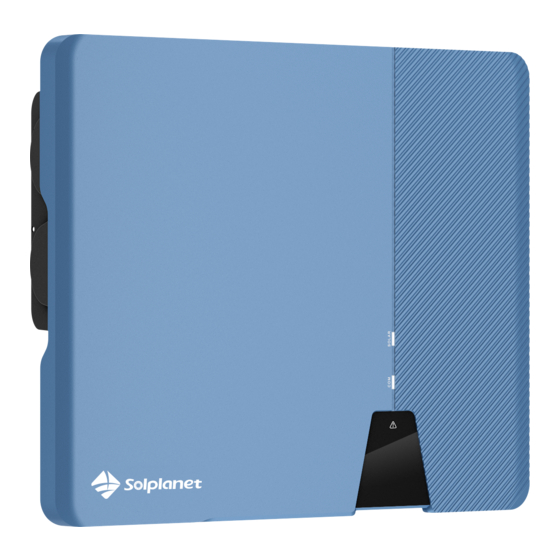Table of Contents
Advertisement
Quick Links
Advertisement
Table of Contents

Summarization of Contents
Notes on this Manual
General Notes
ASW LT-G2 series inverter converts DC to AC and feeds into the utility grid.
Area of Validity
Manual covers mounting, installation, commissioning, and maintenance of ASW LT-G2 inverters.
Target group
Document is for qualified electricians who must perform tasks exactly as described.
Symbols used in this manual
Explains safety symbols like DANGER, WARNING, CAUTION, NOTICE, and INFORMATION.
Safety
Intended use
ASW LT-G2 inverter converts DC to AC, suitable for indoor/outdoor use, operated with PV arrays.
Important safety information
DANGER: Risk of electric shock from live components; DANGER: Risk of high voltages from PV array.
Symbols on the label
Explains symbols like danger zone, high voltage, hot surfaces, WEEE, CE, TUV, RCM, and capacitor discharge.
Unpacking
Scope of delivery
Lists items included in the package: Inverter, Wall bracket, DC connector, AC connector, Documentation, etc.
Check for transport damage
Instructs to inspect packaging for damage upon delivery and report any issues.
Mounting
Requirements for mounting
DANGER: Fire/explosion risk from flammable materials; must be out of reach of children, cannot be touched.
Mounting the inverter
CAUTION: Risk of injury when lifting or dropping inverter; CAUTION: Risk of injury due to damaged cables when drilling.
Electrical connection
Safety
DANGER: Danger to life due to high voltages from PV array; WARNING: Risk of injury due to electric shock.
Electrical Connection Panel
Identifies connection panel objects: DC-switch, MPP connectors, RS485, Communication Stick, AC connector, grounding screw.
Electrical connection diagram with a separate DC isolator
Local codes may require a separate DC isolator; shows connection diagram.
AC Connection
Conditions for AC connection and cable requirements.
Grid connection
Procedure for grid connection, includes DANGER warning about high voltages.
Additional grounding connection
Connects additional grounding to prevent touch current if AC connector grounding fails.
DC connection
Requirements for PV modules, assembling, disassembling, and connecting the PV array.
Requirements for the DC connetion
PV modules must be same type, identical alignment/tilt; adhere to voltage/current thresholds.
Assembling the DC connectors
DANGER: High voltages on DC conductors; assemble connectors observing polarity (+/-).
Disassembling the DC connectors
DANGER: High voltages on DC conductors; procedure for releasing and separating connectors.
Connecting the PV Array
NOTICE: Overvoltage can destroy inverter; ensure correct polarity and voltage limits.
Conmunication equipment connection
Mounting WiFi/4G Stick, connecting RS485 and smart meter cables.
Mounting the WiFi or 4G Stick
NOTICE: Damage from ESD; mount WiFi/4G Stick to COM3 port.
Connect the RS485 network cable
NOTICE: Wrong wiring can destroy inverter; connect RJ45 to COM1/2.
Connect the smart meter cable
Connecting smart meter cable is same as chapter 5.6.2.
Communication
System monitoring via WLAN
Monitor inverter via 4G/WiFi stick; connection diagrams shown.
Active power control with Smart meter
Inverter controls active power output via smart meter using MODBUS protocol.
Remote firmware update
Update firmware via 4G/WiFi stick without opening cover. Contact Service for details.
Active power control via demand response enabling device (DRED)
DRMs application description; applicable to AS/NZS4777.2:2015; DRM0, DRM5, DRM6, DRM7, DRM8 available.
Communication with the third party device
Connect third party device using Modbus protocol instead of RS485 or WiFi stick.
Earth fault alarm
Inverter complies with IEC 62109-2 for earth fault alarm; red LED indicates fault.
Commissioning
Electrical check
Perform checks: PE connection, DC voltage values, DC voltage polarity. WARNING: DC-Voltage danger.
Mechanical check
Perform checks to ensure inverter is waterproof: mounting, cover, cables.
Safety code check
Choose safety code based on installation location; visit website for details.
Start-up
Describes inverter states: Waiting, Checking, Normal. Inverter starts automatically.
Display
Overview of the control panel
Inverter has a display panel with 3 LED indicators.
LED indicators
Describes SOLAR power indicator, COM communication indicator, and Fault indicator lights.
Technical data
DC input data
Table showing PV module power, input voltage, MPPT range, current, etc. for different models.
AC output data
Table showing rated output power, active power, apparent power, voltage, frequency, current for different models.
General data
Table listing net weight, dimensions, operating temperature, ingress protection, topology, etc.
Safety regulations
Lists safety regulations like internal overvoltage, DC insulation monitoring, EMC immunity, and utility interference.
Tools and torque
Lists tools and their required torque for installation and electrical connections.
Troubleshooting
Presumable Fault
Lists error codes E33, E34 with corresponding corrective measures for fault diagnosis.
Permanent Fault
Lists error codes E01, E03, E05, E07, E08, E10 with corrective measures.
Maintenance
Cleaning the contacts of the DC-switch
Clean DC-switch contacts once per year by cycling ON/OFF 5 times.
Cleaning the heat sink
CAUTION: Risk of injury from hot heat sink; clean with pressurized air or soft brush.

















Need help?
Do you have a question about the ASW13K-LT-G2 and is the answer not in the manual?
Questions and answers